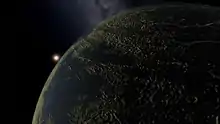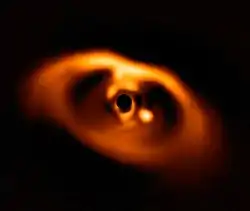Kepler-62e
Kepler-62e (also known by its Kepler Object of Interest designation KOI-701.03) is a super-Earth exoplanet (extrasolar planet) discovered orbiting within the habitable zone of Kepler-62, the second outermost of five such planets discovered by NASA's Kepler spacecraft. Kepler-62e is located about 1,200 light-years (370 pc) from Earth in the constellation of Lyra.[3] The exoplanet was found using the transit method, in which the dimming effect that a planet causes as it crosses in front of its star is measured. Kepler-62e may be a terrestrial or ocean-covered planet; it lies in the inner part of its host star's habitable zone.[1][4]
 Artist's conception of an Earth-size planet orbiting within the habitable zone of its parent star. | |
| Discovery | |
|---|---|
| Discovered by | Borucki et al. |
| Discovery site | Kepler Space Observatory |
| Discovery date | 18 April 2013[1] |
| Transit (Kepler Mission)[1] | |
| Orbital characteristics | |
| 0.427 (± 0.004)[1] AU | |
| Eccentricity | ~0[1] |
| 122.3874 (± 0.0008)[1] d | |
| Inclination | 89.98 (± 0.032)[1] |
| Star | Kepler-62 (KOI-701) |
| Physical characteristics | |
Mean radius | 1.61 (± 0.05)[1] R⊕ |
| Mass | 4.5+14.2 −2.6[2] M⊕ |
| Temperature | 270 K (−3 °C; 26 °F) |
Kepler-62e orbits its host star every 122 days and is roughly 60 percent larger (in diameter) than Earth.[5]
Characteristics
Mass, radius and temperature
Kepler-62e is a super-Earth with a radius 1.61 times that of Earth.[1] This is just above the limit where planets with more than 1.6 R⊕ may be more gaseous than they are rocky, so Kepler-62e may likely be a mini-Neptune. It has an equilibrium temperature of 270 K (−3 °C; 26 °F). It has an estimated mass of 4.5 M⊕, however the true parameter could not be determined, upper limits place it at 36 M⊕, which is unlikely to actually be true.[1]
Host star
The planet orbits a (K-type) star named Kepler-62, orbited by a total of five planets.[1] The star has a mass of 0.69 M☉ and a radius of 0.64 R☉. It has a temperature of 4925 K and is 7 billion years old.[1] In comparison, the Sun is 4.6 billion years old[6] and has a temperature of 5778 K.[7] The star is somewhat metal-poor, with a metallicity ([Fe/H]) of −0.37, or 42% of the solar amount.[1] Its luminosity (L☉) is 21% that of the Sun.[1]
The star's apparent magnitude, or how bright it appears from Earth's perspective, is 13.65. Therefore, it is too dim to be seen with the naked eye.
Orbit
Kepler-62e orbits its host star with an orbital period of 122.3 days at a distance of about 0.42 AU (compared to the distance of Mercury from the Sun, which is about 0.38 AU). A 2016 study came to a conclusion that the orbits of Kepler-62f and Kepler-62e are likely in a 2:1 orbital resonance.[8] This means that for every two orbits of planet "e", "f" completes one around its star. It receives 20% more sunlight than Earth does from the Sun.[1]
Habitability
Given the planet's age (7 ± 4 billion years), stellar flux (1.2 ± 0.2 times Earth's) and radius (1.61 ± 0.05 times Earth's), a rocky (silicate-iron) composition with the addition of a possibly substantial amount of water is considered plausible.[1] A modeling study suggests it is likely that a great majority of planets in Kepler-62e's size range are completely covered by ocean.[9][10] However, given that some studies show that super-Earths above 1.6 R⊕ may have a volatile-rich composition (similar to a mini-Neptune), and Kepler-62e's radius is estimated to be 1.61 R⊕, it may be a gaseous planet with no definite surface, and thus may not be habitable to known terrestrial life forms.[11]
Another factor that is critical is the stellar flux. Given that the stellar flux of Kepler-62e is 20% more than what Earth receives from the Sun, it is possible that the surface temperature of Kepler-62e may be over 350 K (77 °C; 170 °F), enough to trigger a runaway greenhouse effect. Such flux may reduce the habitability factors.
Discovery and cultural impact
In 2009, NASA's Kepler spacecraft was completing observing stars on its photometer, the instrument it uses to detect transit events, in which a planet crosses in front of and dims its host star for a brief and roughly regular period of time. In this last test, Kepler observed 50000 stars in the Kepler Input Catalog, including Kepler-62; the preliminary light curves were sent to the Kepler science team for analysis, who chose obvious planetary companions from the bunch for follow-up at observatories. Observations for the potential exoplanet candidates took place between 13 May 2009 and 17 March 2012. After observing the respective transits, which for Kepler-62e occurred roughly every 122 days (its orbital period), it was eventually concluded that a planetary body was responsible for the periodic 122-day transits. The discovery, along with the planetary system of the star Kepler-69 were announced on April 18, 2013.[1]
On 9 May 2013, a congressional hearing by two U.S. House of Representatives subcommittees discussed "Exoplanet Discoveries: Have We Found Other Earths?," prompted by the discovery of exoplanet Kepler-62f, along with Kepler-62e and Kepler-69c. A related special issue of the journal Science, published earlier, described the discovery of the exoplanets.[13] Kepler-62f and the other Kepler-62 exoplanets are being specially targeted as part of the SETI search programs.[14]
At nearly 1,200 light-years (370 pc) distant, Kepler-62e is too remote and its star too far for current telescopes or the next generation of planned telescopes to determine its mass or whether it has an atmosphere. The Kepler spacecraft focused on a single small region of the sky but next-generation planet-hunting space telescopes, such as TESS and CHEOPS, will examine nearby stars throughout the sky.
Nearby stars with planets can then be studied by the upcoming James Webb Space Telescope and future large ground-based telescopes to analyze atmospheres, determine masses and infer compositions. Additionally the Square Kilometer Array would significantly improve radio observations over the Arecibo Observatory and Green Bank Telescope.[15]
See also
- Habitability of natural satellites
 Kepler-62e
Kepler-62e - Kepler-62f, another exoplanet in the Kepler-62 system
- List of potentially habitable exoplanets
References
- Borucki, William J.; et al. (18 April 2013). "Kepler-62: A Five-Planet System with Planets of 1.4 and 1.6 Earth Radii in the Habitable Zone". Science Express. 340 (6132): 587–90. arXiv:1304.7387. Bibcode:2013Sci...340..587B. doi:10.1126/science.1234702. PMID 23599262.
- "PHL's Exoplanets Catalog - Planetary Habitability Laboratory @ UPR Arecibo".
- Kepler-62e: Super-Earth and Possible Water World
- 3 Potentially Habitable 'Super-Earths' Explained (Infographic)
- Super-Earths: Two Earth-like planets that could host life discovered. Indian Express. 20 April 2013
- Fraser Cain (16 September 2008). "How Old is the Sun?". Universe Today. Retrieved 19 February 2011.
- Fraser Cain (15 September 2008). "Temperature of the Sun". Universe Today. Retrieved 19 February 2011.
- "Kepler-62f: A Possible Water World".
- "Water worlds surface: Planets covered by global ocean with no land in sight". Harvard Gazette. 18 April 2013. Retrieved 19 April 2013.
- Kaltenegger, L.; Sasselov, D.; Rugheimer, S. (October 2013). "Water Planets in the Habitable Zone: Atmospheric Chemistry, Observable Features, and the case of Kepler-62e and −62f". The Astrophysical Journal. 1304 (2): 5058. arXiv:1304.5058. Bibcode:2013ApJ...775L..47K. doi:10.1088/2041-8205/775/2/L47.
- Leslie A. Rogers "Most 1.6 Earth-Radius Planets are not Rocky"
- Clavin, Whitney; Chou, Felicia; Johnson, Michele (6 January 2015). "NASA's Kepler Marks 1,000th Exoplanet Discovery, Uncovers More Small Worlds in Habitable Zones". NASA. Retrieved 6 January 2015.
- Staff (3 May 2013). "Special Issue: Exoplanets". Science. Retrieved 18 May 2013.CS1 maint: uses authors parameter (link)
- "Has Kepler Found Ideal SETI-target Planets?". SETI Institute. 19 April 2013. Archived from the original on 29 October 2013. Retrieved 17 September 2013.
- Siemion, Andrew P.V.; Demorest, Paul; Korpela, Eric; Maddalena, Ron J.; Werthimer, Dan; Cobb, Jeff; Langston, Glen; Lebofsky, Matt; Marcy, Geoffrey W.; Tarter, Jill (3 February 2013). "A 1.1 to 1.9 GHz SETI Survey of the Kepler Field: I. A Search for Narrow-band Emission from Select Targets". Astrophysical Journal. 767 (1): 94. arXiv:1302.0845. Bibcode:2013ApJ...767...94S. doi:10.1088/0004-637X/767/1/94.
External links
| Wikimedia Commons has media related to Kepler-62 e. |





